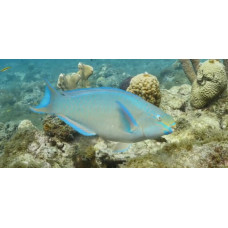Latin name
Scarus vetula
Other names
Blownose, blue chub, blue parrotfish, blueman, joblin crow parrot, moontail, okra peji, slimy head
Identification
Adults are large fish with a spindle-shaped body and a beak-like mouth.
Features of fish fins
Dorsal spines (total): 9; Dorsal soft rays (total): 10; Anal spines: 3; Anal soft rays: 9.
Fish colouring
They have two distinct phases of colouration. In small fish, the sexes are similar, but almost all females are reddish brown or greyish brown, with a lighter head and a white lateral stripe down each side, and this colouration remains in females as they grow larger. At an average length of 25 centimetres (10 inches), females change sex and become male. Larger males enter a new phase of colouration, becoming pale bluish-green with blue spots near the mouth, yellowish stripes between the mouth and eyes, and pale blue stripes on the pectoral fins.
Distribution
West Central Atlantic: from Bermuda, Florida (USA) and the Bahamas to northern South America; throughout the Caribbean.
Habitat
Tropical marine species. Inhabits reefs in the tropical western Atlantic and Caribbean. They inhabit both rocky and coral reefs at depths of up to 25m (80ft).
Size
Maximum length: 61.0 cm. Normal length: 32.0 cm.
Behavior
Forms permanent harem groups of one male and several smaller females.
It is a diurnal fish, lying on the seabed or hiding in crevices at night, covered with a layer of mucus which it secretes and which can help to hide it from predators.
Food and feeding habits
They feed mainly on algae, which they can scrape off the surface, and coral from coral reefs, but they can also feed on sponges and other fouling organisms. In the process, they ingest many mineral particles that settle to the seabed as fine sand.
Reproduction
They are protogynous hermaphrodites. During courtship, the male circles the female constantly. When the female accepts his advances, she joins him and they circle together, releasing eggs into the sea. After fertilisation, the eggs hatch into larvae that become part of the plankton.
Fishing
Small-scale commercial fishing.
Relationship with a person
This species has strong jaws with serrated edges and strong jaw muscles, the fish can cause considerable damage to corals by scraping off food.
There have been reports of ciguatera poisoning.
They are kept in aquariums.
| Classification | |
| Phylum | Chordata |
| Class | Actinopterygii |
| Squad | Labriformes |
| Family | Scaridae |
| Genus | Scarus |
| Species | S. vetula |
| Features | |
| Conservation status | Least Concern |
| Habitat | Pelagic |
| Life span, years | No information |
| Maximum body weight, kg | No information |
| Maximum length, cm | 61 |
| Sailing speed, m/s | No information |
| Threat to people | Edible |
| Way of eating | Planktonophage |
Queen parrotfish
Tags: queen parrotfish




